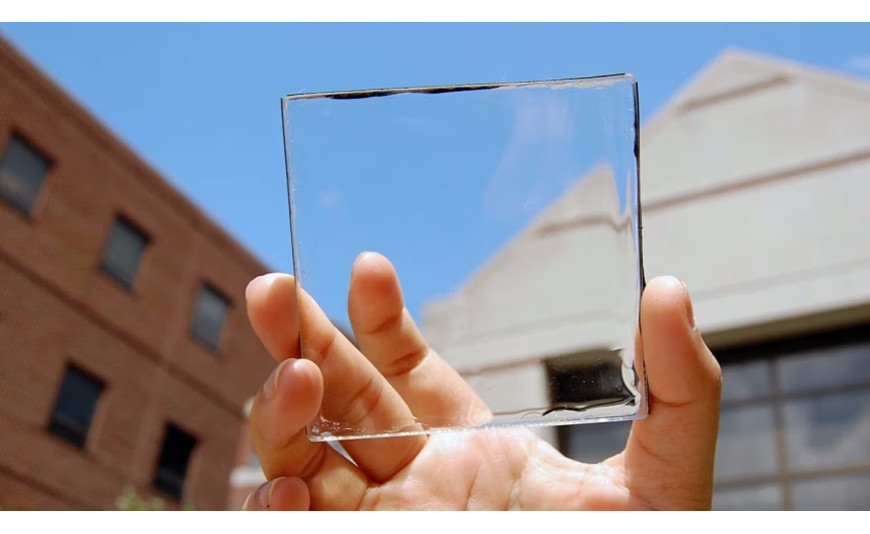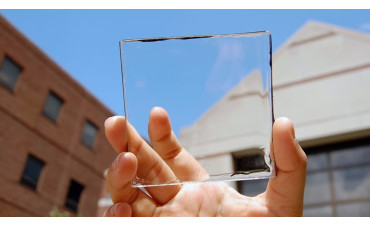Transparent Photovoltaic Panels

Transparent Photovoltaic Panels
Transparent solar panels represent an innovative solution in the field of renewable energy, enabling the generation of electricity while allowing visible light to pass through, which opens up a wide spectrum of applications in construction, architecture, and consumer electronics.
Technology of organic photovoltaic cells
Organic photovoltaic cells (OPV) are devices built from compounds containing carbon atoms, using polymers and small organic molecules capable of absorbing solar radiation and conducting electricity. The structure of a typical organic cell consists of layers placed between electrodes (including one transparent), where the active layer, which is a mixture of donor and acceptor compounds of electrons, plays a key role. The manufacturing process includes mixing electron-donating and accepting molecules with a solvent, creating a thin active layer, and vaporizing the electrodes, with aluminum usually being the cathode.
OPV cells are distinguished by numerous advantages: they are flexible, semi-transparent, lightweight and can contain an even 1000 times thinner light-absorbing layer than silicon cells. Despite these advantages, the technology faces challenges in the form of low efficiency, low operating stability, and short lifespan, mainly due to susceptibility to degradation under the influence of moisture, oxygen, and sunlight. Research focuses on improving these parameters, and the latest achievements have made it possible to obtain energy conversion at almost 20%. Scientists are working to understand the transport of charges in these cells, discovering that the density of states responsible for this process is more complex than previously thought.
Applications in building facades
Transparent solar panels find particularly promising application in building-integrated photovoltaics (BIPV), where they are seamlessly incorporated into structural elements such as facades, roofs, and windows. This technology serves a dual function – it is an integral part of the building's cladding while converting solar energy into electricity. It is estimated that in the United States alone there is the potential to use approximately 7 billion square meters of glass surfaces, from home windows to skyscraper facades, which could be utilized by transparent photovoltaic cells.
Practical applications of this technology include:
- Integration with building facades without negatively affecting their aesthetics.
- Use in greenhouses, where panels not only provide energy for heating and lighting but also reduce energy expenditure (by about 20% in one German project).
- Installation on windows, glass roofs, and elevations, where traditional opaque panels could not be used.
- Implementation in skylights, where natural light is essential, while maintaining the energy generation function.
Efficiency of semi-transparent panels
The efficiency of semi-transparent photovoltaic panels is a compromise between light transmittance and energy efficiency. Unlike standard monocrystalline panels, which achieve an efficiency of 19-24%, semi-transparent modules typically have slightly lower efficiency due to their ability to transmit some of the solar radiation. The Swiss CLI400M10 model, using 108 TOPCon monocrystalline cells, is an example of advanced BIPV (Building Integrated Photovoltaics) technology that maintains high performance despite its semi-transparent design.
Key parameters affecting the efficiency of semi-transparent panels:
- Cell production technology - monocrystalline solutions offer the highest efficiency.
- Weather conditions - sunlight and temperature directly affect energy gain.
- Durability - high-quality semi-transparent panels retain up to 88% of their original performance after 30 years of use.
- Orientation and angle of inclination - proper installation can significantly increase efficiency, with a correctly installed 1 kWp of nominal power generating approximately 1000 kWh per year in Poland.
Optimization of Plant Growth
Semi-transparent photovoltaic panels offer unique benefits for plants in buildings, especially in greenhouses. Research from North Carolina State University showed that lettuce grown under organic solar cells (ST-OSC) did not show significant differences in key parameters, such as antioxidant levels, CO₂ absorption, size, and weight, compared to plants grown under standard conditions. This is because these specialized panels mainly absorb wavelengths of light not used by plants in the photosynthesis process.
Advanced agrivoltaic systems further optimize plant growth by:
- Converting UV radiation into the red spectrum, more beneficial for photosynthesis thanks to the use of nanotechnology.
- Creating a favorable microclimate through partial shading, which reduces plant heat stress.
- Regulating temperature in greenhouses, which eliminates the need for additional heating or cooling.
- Increasing plant biomass production by up to 50% with proper panel placement.
Advanced Semiconductor Materials
Transparent photovoltaic panels use innovative materials and technologies that allow them to selectively absorb light wavelengths invisible to the human eye, while allowing visible light to pass through. Key materials used in these structures are indium tin oxide (ITO), tungsten disulfide, and organic salts, which absorb ultraviolet and infrared radiation. Researchers at Michigan State University developed the first fully transparent cells in 2014, using organic compounds to absorb invisible wavelengths, allowing the glass to function as a typical pane while producing energy.
Technologically, transparent panels are divided into several types:
- Perovskite solar cells with a wide band gap, acting as efficient UV absorbers.
- Dye-sensitized solar cells absorbing near-infrared (NIR).
- Organic photovoltaic cells (OPV) using carbon compounds, offering flexibility and lower production costs.
- Tandem systems combining different technologies, achieving energy conversion efficiency (PCE) up to 14% with an average visible light transmittance (AVT) above 55%.
The latest achievements in this field allow for the creation of cells with transparency reaching 80% with efficiency up to 8%, which visually resembles a double-glazed window. Although the current efficiency of transparent panels is lower than traditional silicon solutions, their application potential and ongoing research suggest a significant development of this technology in the coming years.
You must be logged in to post comments






0 Comments